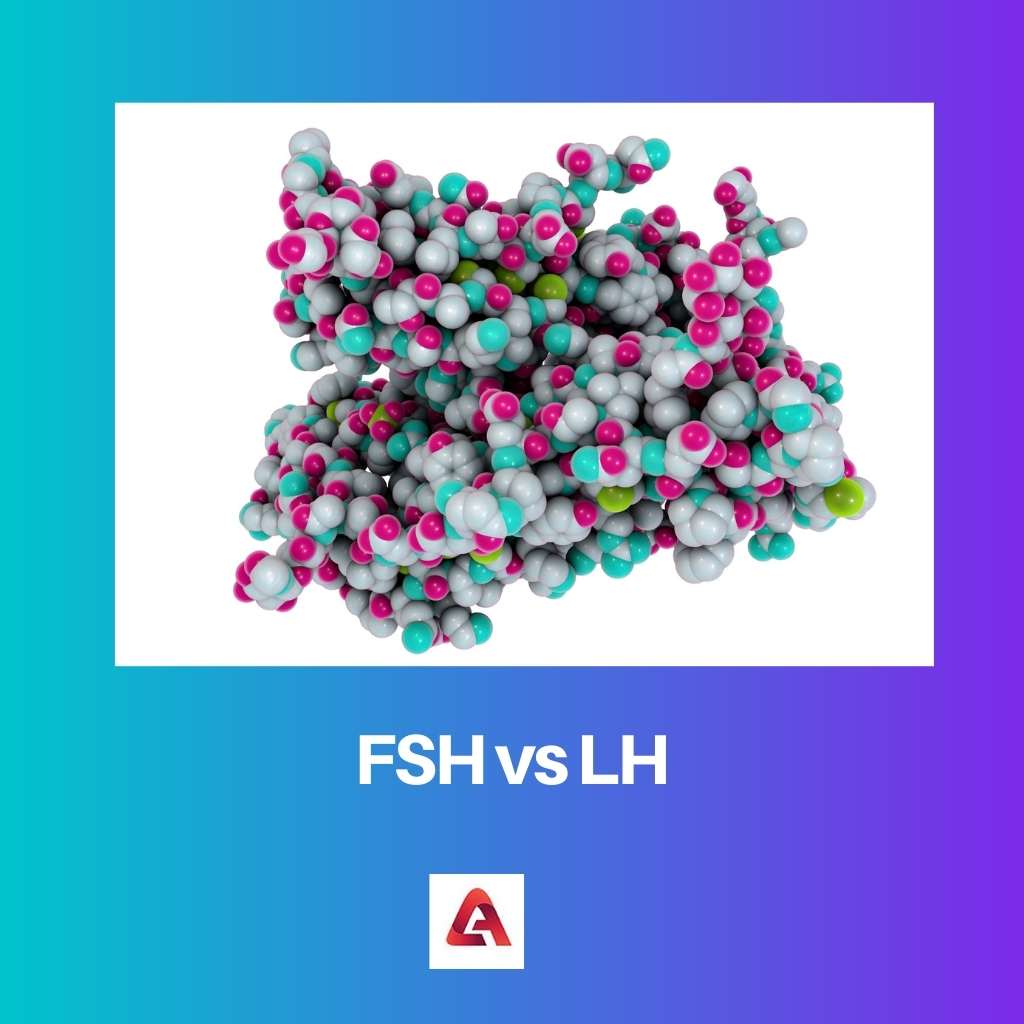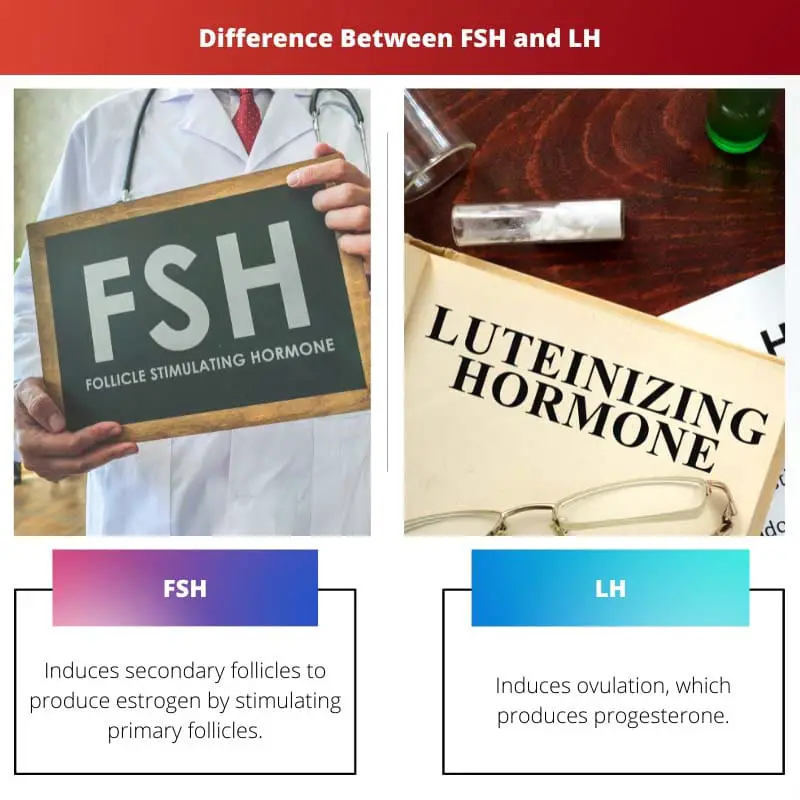Gonadotropins combine two words, gonads (meaning organs that make gametes) and tropins (meaning stimulating hormones). Hence, gonadotropins are hormones that help produce other reproductive hormones.
This is accomplished by stimulating the ovaries and testes. FSH, short for Follicle-stimulating hormone, and LH, short for luteinizing hormone, are the two primary gonadotropins.
The pituitary gland, located inside the brain, produces these hormones. While both of these hormones serve the same essential functions, they also have some crucial differences.
Key Takeaways
- Follicle-stimulating hormone (FSH) stimulates the growth of ovarian follicles in women and sperm production in men while luteinizing hormone (LH) triggers ovulation and testosterone production.
- Both FSH and LH are gonadotropin hormones produced by the anterior pituitary gland.
- Abnormal levels of FSH and LH can lead to fertility issues in both men and women.
FSH vs LH
FSH stimulates the growth and development of ovarian follicles in females and the production of sperm in males. LH is responsible for the release of the mature egg from the ovary in females and the production of testosterone in males. In females, it triggers ovulation and the formation of the corpus luteum.

Follicle-stimulating hormone, or FSH, is the gonadotropin responsible for menstruation in females. It also controls ovulation and several other reproductive functions of humans.
FSH stimulates the primary follicle in females and helps it become the secondary hair. It also enables the Sertoli cells present in the testes of males to generate the androgen-binding protein.
The Luteinizing Hormone, or LH, is a gonadotropin that works with the FSH to control the reproductive functions of the human body.
The LH hormone moves mature eggs from the ovary to the fallopian tube in females. The LH stimulates testosterone synthesis in men by stimulating the Leydig cells.
Comparison Table
| Parameters of Comparison | FSH | LH |
|---|---|---|
| Functionality in females | Induces secondary follicles to produce estrogen by stimulating primary follicles. | Induces ovulation, which produces progesterone. |
| Functionality in males | It stimulates the Sertoli cells to produce the ABP. | It stimulates Leydig cells to produce testosterone. |
| Sexual organ development | LH does not develop primary sexual organs. | Even if LH is not present in the body, FSH can stimulate the immature follicle. This means that FSH is independent of LH. |
| Reliance | Even if LH is not present in the body, FSH can stimulate the immatabsente. This means that FSH is independent of LH. | If FSH is lacking, LH cannot stimulate the ovulation process. LH is thus dependent on FSH. |
| Effect on menstruation | FSH affects the menstrual cycle. | LH does not affect the menstrual cycle. |
What is FSH?
A female’s ovary is the principal site of FSH action. When a woman begins her menstrual cycle, several primordial oocytes develop into primary follicles.
The primary follicles remain dormant until FSH stimulates it. FSH promotes the formation of secondary follicles from the primary follicle.
Many different cells surround the secondary follicle as it develops. These cells go on to produce estrogen. As a result, FSH plays an integral part in estrogen production in females.
The testes are the site of FSH activity in males. Several types of cells occupy the seminiferous tubule of the male testis. The sustentacular cells, or Sertoli cells, are one of them and are found inside these tubules.
The LH hormone stimulates these Sertoli cells to release ABP (Androgen Binding Protein).
Low FSH levels in females may indicate:
- Egg production by the ovaries is insufficient.
- The pituitary gland is not functioning correctly.
- There’s a problem with the hypothalamus, a part of the brain responsible for regulating the pituitary gland and other functions.
- They’re severely underweight.
When males have low FSH levels, they may be suffering from a pituitary gland or hypothalamic disorder.
What is LH?
LH completes the work started by FSH in females. When the secondary follicle is matured by FSH, it develops into the egg. This process thickens up the granules.
Approximately 14 days into a woman’s menstrual cycle, the LH enters the picture. This hormone promotes the movement of the egg from the ovary into the fallopian tube.
The process is known as ovulation. When ovulation occurs, granular cells turn yellow – known as the luteum corpus. Progesterone is released from these cells when ovulation occurs. It is through LH that progesterone is formed in females.
In males, LH works in conjugation with the FSH. A group of cells called interstitial cells or Leydig cells exists outside the seminiferous tube. LH stimulates these cellsease testosterone by the LH hormone.
LH in excess or insufficient can lead to several problems. Some of these inconveniences include infertility and menstrual disorder in females.
A lowering of sex drive may be observed in males. Both children and adolescents are capable of experiencing early and late puberty.
Main Differences Between FSH and LH
- Primary follicles develop into secondary follicles through FSH, whereas LH initiates the excretion of the eggs from the ovary into the fallopian tubes.
- Sertoli cells produce ABP through FSH, while Leydig cells make testosterone through LH.
- The function of FSH is independent of LH, but the function of LH is dependent on FSH.
- FSH develops the human primary sex organs, while LH does not play a role in this process.
- A woman’s menstrual cycle is affected by FSH, but not by LH.




